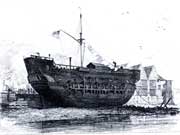Row, Row, Row the Boat — Galley Slavery
Galley slavery existed in ancient Greece and Rome, but it isn't institutionalized in Europe until 1348. (It will last there until 1803.) This particular form of penal bondage flourishes during periods of global expansion and colonization. Starting in about 1500, galley sentences or servitude become common in France, Spain, and Italy. Initially, this is a non-criminal disciplinary measure aimed at the poor and marginal. Changing attitudes about these populations lead to an increasingly punitive approach, however.
Vagrants, thieves, and beggars are sometimes rounded up off the streets for this purpose. The vessels are enormous and need hundreds of slaves to power them — offenders are often the largest group of laborers onboard during sea voyages. Even though their work is vital and valuable, mistreatment is the norm. Often required to march across the countryside before boarding the boat, oarsmen are then chained to the oars, forced to sit in their own excrement. Disease and vermin abound. Galley slavery is usually a life sentence.
 |
| Prison ship at Portsmouth Harbor, convicts going on board |